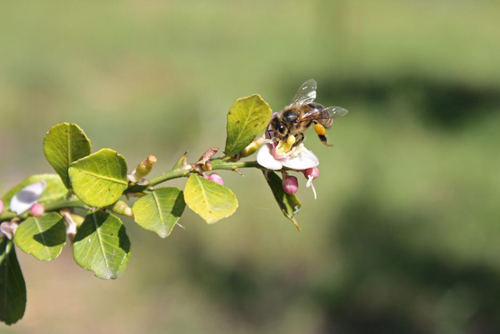ABC Rural By Eliza Rogers
Reprinted with Permission
 Bees are a vital part of the ecosystem and economy,
Bees are a vital part of the ecosystem and economy,
but bad mating could cause damage.
Beekeepers are on alert after tests found Australia’s European honeybees are breeding with the destructive Asian honeybee.
Sperm from the Asian honeybee, that carries the deadly Varroa mite, was found in one third of commercial queens tested in the Cairns region of Far North Queensland.
It produces useless eggs, reducing the honey and pollination services from affected hives.
But beekeepers are not surprised or alarmed.
Audio: Researcher and beekeeper discuss dangerous cross-breeding (ABC Rural)
The Asian honeybee was first detected in Cairns seven years ago, and since then, a plan has been set up to manage the incursion.
Research conducted as part of that plan has revealed the unnatural mating, which makes the European bees’ eggs unviable.
Michael Hornitzky, from the Honey Bee and Pollination Program advisory committee, says it could damage honey and pollination capacity.
“As the Asian honeybee becomes more widespread, the inter-specific mating will increase, and that results in less worker bees.”
Cairns beekeeper Maurie Damon’s bees were involved in the research, and he says the findings are concerning but not critical.
He hasn’t noticed any major impact, saying the queens, who mate with multiple drones, are still productive enough, and the reject eggs become a food source.
“The queen will be less productive than she should be, but it doesn’t mean that it’s going to completely lose production,” he said.
“The workers… pick up immediately that the eggs that are hybrids… are not right… so they (eat) them as a protein source.”
Mr Damon says the population levels are reduced, but it’s hard to say how much.
In a positive twist, the mating doesn’t work the other way .
Mr Damon says the Asian honeybee queens can die if they mate with the European honeybee drones, because they’re much larger.
He’s urging Cairns beekeepers to source queens from further afield to maintain a robust genetic pool.
Other beekeepers are also encouraged to get queen bees from areas other than Cairns, which Mr Damon denies will affect business.
“The queen breeding exercises in Cairns are mostly beekeepers breeding their own. There is practically nothing going outside the Cairns area.”
But Mr Damon does expect the bad crossbreeding to worsen when the bees breed up in warmer, wetter weather.
Trevor Weatherhead, from the Australian Honeybee Industry Council, which has funded the new research, says the inter-specific breeding is exactly what the industry expected.
He says he’s asking the State Government to set up a control area in North Queensland to protect domestic and international bee markets.
“We’ve been proposing that we have either a control area or biosecurity zone from about Kennedy north, so that bees in that northern area wouldn’t be able to come south without a permit.”
There is a national bee pest surveillance program in place to detect new incursions of bee pests and pest bees.